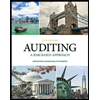
FINANCIAL ACCOUNTING-TEXT
6th Edition
ISBN: 2810023103767
Author: DYCKMAN
Publisher: CAMB BUS
expand_more
expand_more
format_list_bulleted
Concept explainers
Question
Chapter 2, Problem 3MC
To determine
Identify the effect of decline in the asset value.
Expert Solution & Answer
Want to see the full answer?
Check out a sample textbook solution
Students have asked these similar questions
Are there any tax incentives or deductions delta takes advantage of when investing in property, plant, and equipment?
Can you help me solve this general accounting question using the correct accounting procedures?
Can you provide the accurate answer to this financial accounting question using correct methods?
Chapter 2 Solutions
FINANCIAL ACCOUNTING-TEXT
Ch. 2 - Prob. 1MCCh. 2 - Prob. 2MCCh. 2 - Prob. 3MCCh. 2 - Prob. 4MCCh. 2 - Prob. 5MCCh. 2 - Prob. 1QCh. 2 - Prob. 2QCh. 2 - Prob. 3QCh. 2 - Prob. 4QCh. 2 - Prob. 5Q
Ch. 2 - Prob. 6QCh. 2 - Prob. 7QCh. 2 - Prob. 8QCh. 2 - Prob. 9QCh. 2 - Prob. 10QCh. 2 - Prob. 11QCh. 2 - Prob. 12QCh. 2 - Prob. 13QCh. 2 - Prob. 14MECh. 2 - Prob. 15MECh. 2 - Prob. 16MECh. 2 - Prob. 17MECh. 2 - Prob. 18MECh. 2 - Prob. 19MECh. 2 - Prob. 20MECh. 2 - Prob. 21MECh. 2 - Prob. 22MECh. 2 - Prob. 23MECh. 2 - Prob. 24MECh. 2 - Prob. 25MECh. 2 - Prob. 26MECh. 2 - Prob. 27MECh. 2 - Prob. 28MECh. 2 - Prob. 29MECh. 2 - Prob. 30MECh. 2 - Prob. 31MECh. 2 - Prob. 32MECh. 2 - Prob. 33MECh. 2 - Prob. 34ECh. 2 - Prob. 35ECh. 2 - Prob. 36ECh. 2 - Prob. 37ECh. 2 - Prob. 38ECh. 2 - Prob. 39ECh. 2 - Prob. 40ECh. 2 - Prob. 41ECh. 2 - Prob. 42ECh. 2 - Prob. 43ECh. 2 - Prob. 44ECh. 2 - Prob. 45ECh. 2 - Prob. 46ECh. 2 - Prob. 47ECh. 2 - Prob. 48ECh. 2 - Prob. 49PCh. 2 - Prob. 50PCh. 2 - Prob. 51PCh. 2 - Prob. 52PCh. 2 - Prob. 53PCh. 2 - Prob. 54PCh. 2 - Prob. 55PCh. 2 - Prob. 56PCh. 2 - Prob. 57PCh. 2 - Prob. 58PCh. 2 - Prob. 59PCh. 2 - Prob. 60PCh. 2 - Prob. 61PCh. 2 - Prob. 62PCh. 2 - Prob. 63PCh. 2 - Prob. 64PCh. 2 - Prob. 65PCh. 2 - Prob. 66PCh. 2 - Prob. 67PCh. 2 - Prob. 68PCh. 2 - Prob. 69PCh. 2 - Prob. 70PCh. 2 - Prob. 71CPCh. 2 - Prob. 72CP
Knowledge Booster
Learn more about
Need a deep-dive on the concept behind this application? Look no further. Learn more about this topic, accounting and related others by exploring similar questions and additional content below.Similar questions
- Can you explain the correct approach to solve this general accounting question?arrow_forwardPlease provide the answer to this general accounting question using the right approach.arrow_forwardI am searching for the accurate solution to this general accounting problem with the right approach.arrow_forward
- D&G ENTERPRISES ISSUES BOND WITH A $1,000 FACE VALUE THAT MAKES COUPON PAYMENTS OF $10 EVERY 3 MONTHS. WHAT IS THE COUPON RATE? A. 1% B. 4% C. 6% D. 8% E. 12%arrow_forwardCan you help me solve this general accounting question using the correct accounting procedures?arrow_forwardI am looking for a reliable way to solve this financial accounting problem using accurate principles.arrow_forward
- Can you explain the correct approach to solve this general accounting question?arrow_forwardCan you demonstrate the proper approach for solving this financial accounting question with valid techniques?arrow_forwardCan you solve this general accounting problem using accurate calculation methods?arrow_forward
- A company had an income of $60,000 using absorption costing for a given period. Beginning and ending inventories for that period were 13,000 units and 18,000 units, respectively. Ignoring income taxes, if the fixed overhead application rate was $3.00 per unit, what was the income using variable costing? A. $75,000. B. $60,000. C. $45,000. D. Not sufficient information to determine.arrow_forwardCan you solve this general accounting problem with appropriate steps and explanations?arrow_forwardAn asset has a book value of $22,500 on December 31, Year 4. The asset has been depreciated at a straight-line rate of $5,000 per year. If the asset is sold on December 31, Year 4 for $19,000, what should the company record? • a. A loss on sale of $3,500 • b. A gain on sale of $3,500 . c. Neither a gain nor a loss is recognized . • d. A loss on sale of $1,000 e. A gain on sale of $1,000arrow_forward
arrow_back_ios
SEE MORE QUESTIONS
arrow_forward_ios
Recommended textbooks for you
 Auditing: A Risk Based-Approach (MindTap Course L...AccountingISBN:9781337619455Author:Karla M Johnstone, Audrey A. Gramling, Larry E. RittenbergPublisher:Cengage LearningPrinciples of Accounting Volume 1AccountingISBN:9781947172685Author:OpenStaxPublisher:OpenStax College
Auditing: A Risk Based-Approach (MindTap Course L...AccountingISBN:9781337619455Author:Karla M Johnstone, Audrey A. Gramling, Larry E. RittenbergPublisher:Cengage LearningPrinciples of Accounting Volume 1AccountingISBN:9781947172685Author:OpenStaxPublisher:OpenStax College College Accounting, Chapters 1-27AccountingISBN:9781337794756Author:HEINTZ, James A.Publisher:Cengage Learning,
College Accounting, Chapters 1-27AccountingISBN:9781337794756Author:HEINTZ, James A.Publisher:Cengage Learning,

Auditing: A Risk Based-Approach (MindTap Course L...
Accounting
ISBN:9781337619455
Author:Karla M Johnstone, Audrey A. Gramling, Larry E. Rittenberg
Publisher:Cengage Learning

Principles of Accounting Volume 1
Accounting
ISBN:9781947172685
Author:OpenStax
Publisher:OpenStax College

College Accounting, Chapters 1-27
Accounting
ISBN:9781337794756
Author:HEINTZ, James A.
Publisher:Cengage Learning,
The ACCOUNTING EQUATION For BEGINNERS; Author: Accounting Stuff;https://www.youtube.com/watch?v=56xscQ4viWE;License: Standard Youtube License